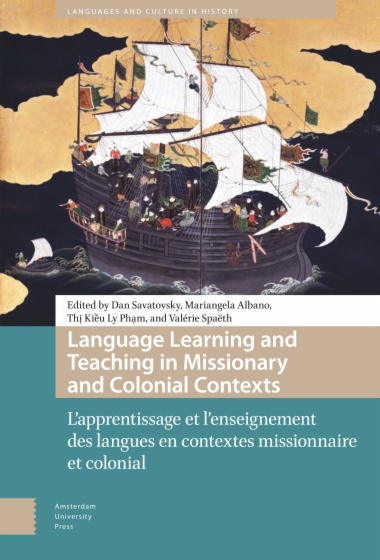This volume assembles texts dedicated to the linguistic and educational aspects of missionary and colonial enterprises, taking into account all continents and with an extended diachronic perspective (15th–20th centuries). Strictly speaking, this “linguistics” is contemporary to the colonial era, so it is primarily the work of missionaries of Catholic orders and Protestant societies. It can also belong to a retrospective outlook, following decolonization. In the first category, one mostly finds transcription, translation, and grammatization practices (typically, the production of dictionaries and grammar books). In the second category, one finds in addition descriptions of language use, of situations of diglossia, and of contact between languages. Within this framework, the volume focuses on educational and linguistic policies, language teaching and learning, and the didactics that were associated with them.
- Cover
- Table of Contents
- Introduction: Language teaching and grammatization in the colonial empires
- I Iberian Mission Lands
- 1 Toward a historiography of foreign language documentation, teaching and learning of non-Western languages in a missionary context (16th–18th centuries)
- 2 A contribution to the history of missionary grammars and Romance languages grammars: The commensurability of metalanguage and categories in the sixteenth century
- II The Sinic World
- 3 Learning a language while making it up. Matteo Ricci’s ways of inculturation and the communicative strategy of the Company of Jesus
- 4 For an epistemological and cognitive approach to Matteo Ricci’s The Palace of Memory. Didactics and imaginative processes
- † Maria Lucia Aliffi and Mariangela Albano
- 5 The role of British missionary scholars in setting the foundations for the academic study of Chinese in British universities
- Tinghe Jin and Steven Cowan
- III West Africa
- 6 Language policy within the French colonial army: The First World War and beyond
- 7 The “civilization-language-culture” relationship in reading books for teaching in French to allophone schoolchildren (1885–1930): A window opened to the past
- IV East Africa
- 8 From teaching non-Arabs Arabic to Arabization in 1950s Sudan
- 9 Italian colonial educational policy in the Horn of Africa
- V Middle East
- 10 How to create a language by describing it? Orientalists and pure colloquial Arabic
- 11 Politique d’enseignement au Liban au début du Mandat français : les manuels scolaires en français et la place de l’arabe au Collège de Beyrouth
- VI Southeast Asia
- 12 The Romanized writing of Vietnamese: A unique case in the Far East
- Thị Kiều Ly Phạm and Mariangela Albano
- 13 On Indonesian and English as lingua francas: Colonial, national, global
- VII Europe
- 14 Un empire culturel et littéraire : quelques grammaires de l’italien langue étrangère (seizième–dix-septième siècle)
- 15 “A language that reigns in the city”: Italian in grammar books for foreigners (second half of the 18th century)
- 16 L’enseignement du grec moderne comme langue étrangère : des missionnaires catholiques aux grammairiens philhellènes
- Lélia (Evangélia) Pantéloglou
- List of abbreviations (Index)
- Index of names
- Index of languages and script names
- List of Figures
- Fig. 1a. Annotated translation in Quintana’s Compendio de Vozes Mixes (1733), fol. 97
- Fig. 1b. Quintana’s Compendio de Vozes Mixes (1733), fol. 126
- Fig. 2a Alphabetum Armenum (1784), frontispiece
- Fig. 2b Alphabetvm Ibericvm siue Georgianvm vulgare (1629), frontispiece
- Figs. 3a & 3b. Hernández, Doctrina Christiana en lengva misteca (1568), fols. LV and LXII
- Figs. 4a & 4b. Flores, Arte de la lengva metropolitana del reyno Cakchiquel (1753), fols. 36 and 286
- Figs. 5a, 5b, & 5c. Flores, Arte de la lengva metropolitana del reyno Cakchiquel (1753), fols. 284, 127, and 108
- E: English, S: Spanish, I: Italian, P: Portuguese, F: French
- Fig. 6. Morrison, Dictionary of the Chinese Language, vol. 1 (1815), p. 44240
- Fig. 7. “Map of the races of French West Africa providing Senegalese tirailleurs” (legend), in La Dépêche coloniale illustrée, February 1917, n.p. [23>24]: “French West Africa and black troops”
- Fig. 8. Cover of Ferrage, Petit manuel français-bambara à l’usage des troupes noires (1918)
- Fig. 9. Excerpt taken from Ferrage, Petit manuel français-bambara à l’usage des troupes noires (1918)
- Fig. 10. Excerpt taken from: Anonymous, Le français tel que le parlent nos tirailleurs sénégalais (1916), p. 21
- Fig. 11. Drawing taken from La dépêche coloniale illustrée, February 1917, n.p.: “French West Africa and the black troops”
- Fig. 12. G. Bruno, Le tour de la France par deux enfants (last page, 1904 edition)
- Figs. 13a & 13b. Louis Machuel, Méthode de lecture (1885). Lesson 12, “Vengeance d’un éléphant”
- Fig. 14. Sonolet and Pérès, Méthode de lecture: “Les métiers” [Professions] (1915)
- Fig. 15. Davesne, Mamadou et Bineta (1931). Ch. 1—“School” and Ch. 2—“The Human Body”
- Fig. 16. M. Fresco, Syllabaire (1891):”Monsieur Paul écrit,” 90–91
- Fig. 17. De Rhodes, Dictionarivm Annamiticvm… (1651), col. 1-2
- List of Tables
- Table 1. circonlocution and périphrase in French grammars before 1600
- Table 2. circunloquio and rodeo in Portuguese grammars (Barros) and Spanish grammars before 1600
- Table 3. Terms suplir/suprir, circunloquio/circunlóquio and rodeo in the first missionary grammars
- Table 4. Chronology of compulsory schooling in Italy
- Table 5. Public colonial schools in Eritrea and Somalia (1935)
- Table 6. António de Fontes. Signs for tones, ARSI. Jap-Sin 85, fols. 89r–123r.
- Table 7. Examples of English/Malay lexical usage
- Tableau 8. L’enseignement/apprentissage du grec moderne (dix-septième–dix-neuvième siècle)

